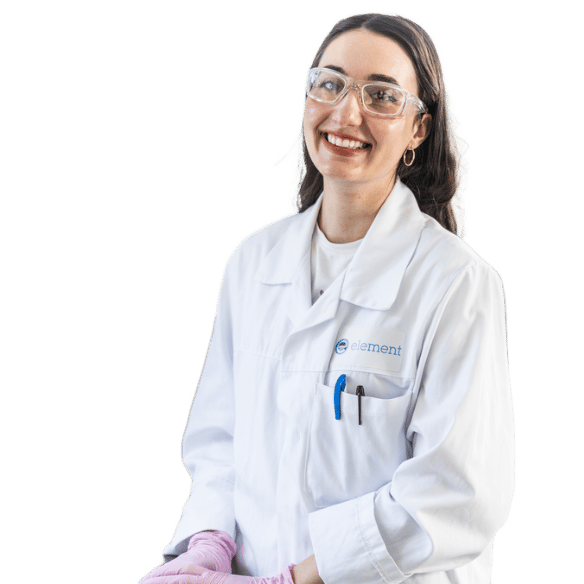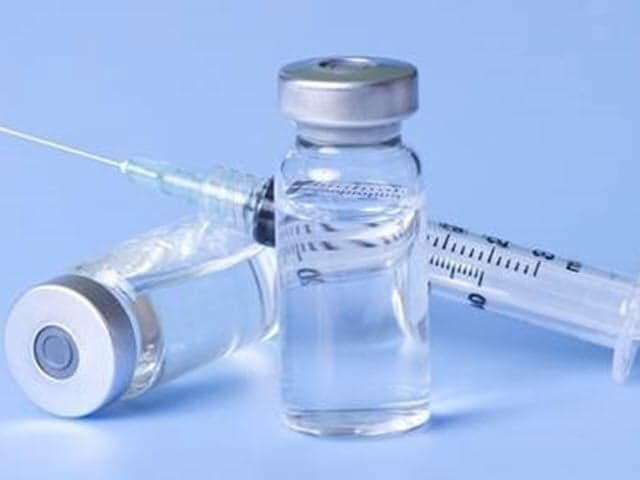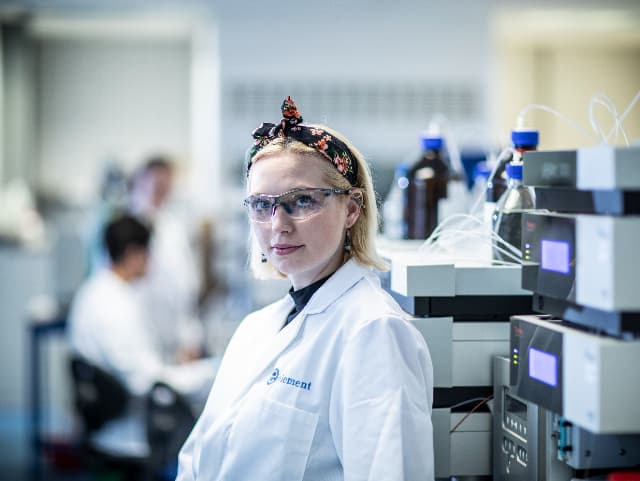Analytical Testing Services
Get comprehensive analytical testing support that accelerates your product development while maintaining regulatory compliance. Our GMP, GLP, and ISO/IEC 17025 accredited laboratories deliver tailored solutions across the life sciences sector, helping you bring safe, compliant products to market faster.

What are Analytical Testing Services at Element?
Analytical testing examines substances, compounds, and materials to understand their chemical composition and behaviors. At Element, we provide comprehensive testing services for life sciences companies, supporting product development from R&D through manufacturing and validation across the entire life sciences sector.

What Can Element Offer You For Analytical Testing Services?
Key tests offered
Key tests offered
We deliver a full spectrum of analytical testing services designed to support your product development and regulatory compliance requirements. Our GMP, GLP, and ISO/IEC 17025 accredited laboratories provide sophisticated analysis across multiple disciplines to meet your specific needs.
Our core testing capabilities include:
Components and materials we test
Components and materials we test
Our comprehensive testing capabilities cover every aspect of your product development needs, from raw materials through finished products. We specialize in analyzing drug active ingredients, packaging materials, pharmaceutical containers and stoppers, and complete pharmaceutical formulations. Our expertise extends to medical device materials, antimicrobial products, and biopharmaceutical compounds, helping you maintain quality and compliance at every stage.
Methods and solutions offered
Methods and solutions offered
Partner with our experts to access customized testing protocols specifically designed for your unique product requirements. We provide end-to-end support from initial R&D through final manufacturing validation, with specialized solutions for pharmaceutical products, medical devices, biopharmaceuticals, and antimicrobial registration for products like disinfectants and sanitizers. Our methodologies are continuously refined to meet evolving regulatory standards while accelerating your time to market.
Which labs offer this service
Which labs offer this service
Our team operates from Life Sciences Testing hubs across the world, providing global access to our expert capabilities. Find your nearest Life Sciences Testing hub on our Locations Page.
Standards we test to and products we test
- FDA requirements
- GxP standards (cGMP, GLP)
- EMA guidelines
- MHRA regulations
- ISO/IEC 17025
- ICH Q3D guidelines
- USP standards
- EP (2.4.20) requirements
- Pharmaceutical products, APIs, and raw materials
- Medical devices
- Biopharmaceutical products
- Antimicrobial products
- Food products
Your Challenges, Our Solutions
Meeting complex regulatory requirements successfully
Accelerating quality product development
Navigating specialized testing requirements effectively
Managing patient safety with confidence
Why Choose Element

Tailored support
Seamless transitions
Product registration support
Direct access to technical experts
Frequently asked questions
What accreditations do your analytical testing laboratories hold?
Our laboratories operate under GxP (cGMP, GLP) standards and ISO/IEC 17025 accreditation, ensuring all testing meets regulatory requirements and industry best practices for quality and reliability.
How can your analytical testing help reduce development timelines?
Our integrated testing approach and comprehensive project management identify potential issues early, preventing costly delays and rework. We coordinate seamless transitions between testing phases while maintaining regulatory compliance at every stage.
Do you provide guidance on testing methodology selection?
Yes, our technical experts work directly with you to determine the most appropriate analytical methodologies for your specific product requirements, helping optimize both accuracy and efficiency.
Can you support testing for international market approvals?
Our testing supports global regulatory submissions, with expertise in FDA, EMA, MHRA, and Health Canada requirements. We provide comprehensive documentation tailored to different international compliance standards.
How do you handle specialized or unique testing requirements?
We develop and validate customized testing protocols for unique product challenges, drawing on our extensive experience across pharmaceutical, medical device, and biopharmaceutical sectors to deliver solutions that meet your specific needs.

Explore our global network of labs and find your nearest location
VIEW ALL LOCATIONSRelated services

Antimicrobial Testing Services
Accelerate antimicrobial product approval with GLP-compliant testing for EPA, FDA, TGA & more. Element delivers trusted efficacy data to meet global regulations & prove effectiveness against emerging pathogens. Learn More.

Residual Solvents Testing – USP 467 & ICH Q3C Services
Element provides testing for residual solvents in pharmaceuticals to ensure finished products are free from toxicologically significant levels of VOCs, per USP <467> and ICH Q3C residual solvents guidelines.

Analytical Method Development & Validation
Element's regulatory and industry experts have a proven track record of successfully developing and validating fit-for-purpose, accurate, and reliable analytical methods based on established CDER/ICH and FDA guidelines and procedures.

Extractables and Leachables Testing Services
Element provides tailored extractables and leachables testing (E&L) studies to ensure patient safety and compliance with regulatory requirements.

Biopharmaceuticals & Biologics Analysis Services
Our clients develop safe, efficacious products with confidence thanks to Element’s Biologics and Advanced Therapy Medicinal Products (ATMPS) testing services.

Pharmaceutical Quality Control Testing
Element provides pharmaceutical quality control testing, covering raw materials, APIs, and finished products. Our expert analytical development and validation help meet regulatory requirements and support all phases of product development.
Speak to our team of experts
GxP compliance
Adherence to current Good Laboratory Practice (GLP) and current Good Manufacturing Practices (cGMP), assures all test quality and regulatory standards are met.
